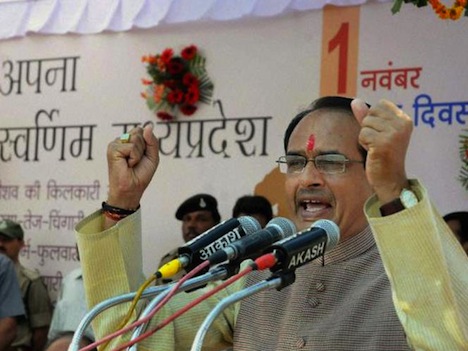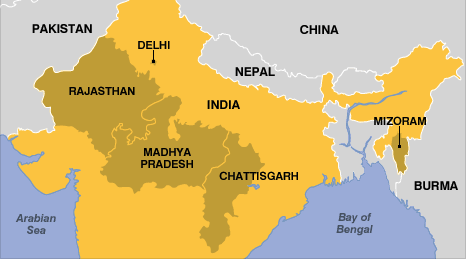In what has been billed as the last electoral test before India goes to the polls for national elections later in spring 2014, a series of five regional contests in northern India are being cast as a sign of strong momentum for India’s conservative Hindu nationalist Bharatiya Janata Party (the BJP, भारतीय जनता पार्टी) and for its charismatic leader Narendra Modi.![]()
Results were released yesterday and today in the five state assembly elections, though regional voting started nearly a month ago on November 11 in Chhattisgarh.
Though commentators are quick to argue that the results are a good sign for the BJP, with the Indian stock market and the Indian rupee surging on news of the BJP victories, it’s important not to confuse an anti-incumbent electorate with an electorate that’s suddenly enthusiastic about a new era of BJP dominance.
Still, the momentum in favor of Modi and the BJP — and against India’s current governing party, the center-left Indian National Congress (Congress, or भारतीय राष्ट्रीय कांग्रेस) — has been growing for quite some time. Many Indian voters are growing weary of a decade of Congress-led rule under prime minister Manmohan Singh, who has been unable to repeat his success as finance minister in the 1990s, when he enacted a series of liberal economic reforms. Neither does the Indian electorate seem excited about Rahul Gandhi, who would succeed Singh as prime minister if the Congress-led United Progressive Alliance (UPA) wins a majority in next spring’s elections. The Indian economy has slowed significantly over the past three years — GDP growth dived from over 10% in 2010 to under 3% last year (and it’s set to grow just 5% this year).
In that regard, Modi’s massive reelection victory to a third term in December 2012 as Gujarat’s chief minister and Congress’s failure to make a breakthrough in the February 2012 Uttar Pradesh state elections are important goalposts as well.
So what actually happened in the latest round of state assembly elections?
Here’s a map of the five states/territories in play, the three largest of which (Madhya Pradesh, Rajasthan and Chhattisgarh) form a wide swath of India’s north-central Hindu heartland. Unlike in many other Indian states, including Uttar Pradesh, Bihar, West Bengal and Kerala, politics in the three north-central states are about as vanilla as Indian politics gets — the state elections were essentially two-party contests between the BJP and Congress. That made the contests important bellwethers as national elections approach.
So how did the parties do?
The BJP will retain its hold on the state of Madhya Pradesh with a moderately larger majority, giving chief minister Shivraj Singh Chouhan (pictured above) a third consecutive term leading India’s sixth-most populous state. The BJP will also retain control of Chhattisgarh’s state assembly. The BJP’s most impressive victory, however, came in Rajasthan, India’s eight-most populous state, where Congress lost 75 seats and the BJP gained 84.
In Delhi, voters also rejected Congress, but not in favor of a majority BJP government. Instead, voters turned to the newly formed Aam Aadmi Party (AAP), an anti-corruption party, which fell three seats short of becoming the largest party in Delhi’s assembly, and which now holds the key to Delhi’s new government.
Congress remained in government only in the small far-eastern state of Mizoram.
While the result, on average, is better news for Modi and the BJP than for Congress, the results (with the exception of Rajasthan) don’t necessarily mean a huge BJP wave is coming. Modi still has two major problems — the first is the hubris of mistaking an anti-incumbent mood for BJP support, and the second is geography.
Nothing demonstrates both problems more than the May 2013 elections in Karnataka state in south-central India. Going into those elections, the BJP had presided over one of India’s most powerful regional economies — Karnataka is home to Bangalore and a booming high-tech economy that has drawn massive amounts of global investment. While Modi campaigned in Karnataka just as vigorously as he did in the most recent elections, it wasn’t enough to save the incumbent BJP government from a spectacular defeat — the BJP lost 70 of its 110 seats in the Karnataka state assembly. Though the Karnataka election also featured unique internal BJP fractures, it’s a potent example that voters have been equally brutal against the BJP this year, too.
But Karnataka, as the first major southern state to elect a BJP government, was supposed to be a model for the BJP’s growth outside of its traditional northern heartland. After this weekend’s election results, the four largest states under BJP control will be Madhya Pradesh, Rajasthan, Chhattisgarh and Modi’s Gujarat, which lies on the coast south of Rajasthan and west of Madhya Pradesh. In southern and eastern India, the BJP remains a relatively minor political force and, until that changes, Modi will never be able to win an outright BJP majority. Instead, the best-case scenario for Modi is to build a coalition with regional and other parties through the National Democratic Alliance (NDA), the BJP-led coalition alternative to the UPA.
Pushing aside national political considerations, here’s a look at the results on a state-by-state basis. Continue reading Anti-incumbent momentum rises with BJP gains in northern Indian regional elections

